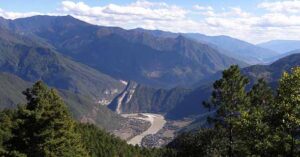 A new study is claiming that the Chinese government has used its dams on the Dzachu [En: Mekong] river, a major river in Tibet, to prevent the flow of water downstream, contributing to a devastating drought in southeast Asia.
A new study is claiming that the Chinese government has used its dams on the Dzachu [En: Mekong] river, a major river in Tibet, to prevent the flow of water downstream, contributing to a devastating drought in southeast Asia.
The study, Monitoring the Quantity of Water Flowing Through the Upper Mekong Basin Under Natural (Unimpeded) Conditions, from Eyes on Earth Inc, a research and consulting company specialising in water, and funded by the United States government, was released on April 10 and confirms what the International Campaign for Tibet and other Tibet advocates have long said: that China’s control of water in Tibet not only deprives Tibetans of their natural resources and human rights, it also endangers the lives of millions of people living downstream.
Tibet is situated on the planet’s highest and largest plateau, and as the source of many of the largest river systems on Earth, Tibet provides water to more than one billion people across Asia. However, the study says, the Chinese occupation of Tibet is threatening this supply of water.
Looking at data from a 28-year period starting in 1992, the study says the amount of water expected to flow naturally from the Upper Mekong was usually close to the amount that actually reached a water gauge at Chiang Saen in Thailand. However, the study says the “relationship between gauge height and natural flow deteriorated after 2012, when a couple of major dams and reservoirs were built, which greatly restricted the amount and timing of water released upstream.”
 The situation was worst in 2019, when recorded river levels in the Lower Mekong were some of the lowest ever. According to the study, there was “above-average” natural flow in the Upper Mekong at that time, but the water simply never made it past China’s dams to reach downstream countries. “The severe lack of water in the Lower Mekong during the [summer] wet season of 2019 was largely influenced by the restriction of water flowing from the upper Mekong during that time,” the study says.
The situation was worst in 2019, when recorded river levels in the Lower Mekong were some of the lowest ever. According to the study, there was “above-average” natural flow in the Upper Mekong at that time, but the water simply never made it past China’s dams to reach downstream countries. “The severe lack of water in the Lower Mekong during the [summer] wet season of 2019 was largely influenced by the restriction of water flowing from the upper Mekong during that time,” the study says.
While the Chinese government was holding back water, southeast Asian countries were facing a severe drought that robbed farmers and fishers of their livelihood and dried up parts of the river completely. “The dams greatly expand institutional capacity to regulate the river flow,” the study notes, “with corresponding impacts downstream that need to be addressed through holistic solutions.”
The Tibet advocacy group the International Campaign for Tibet in the past described how, while damming Tibet’s rivers, China has refused to join any international mechanism regulating the flow of rivers in the region.




 Print
Print Email
Email